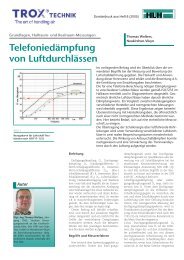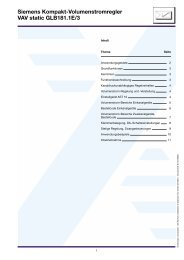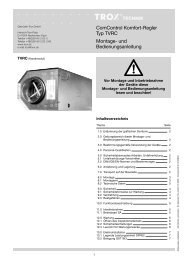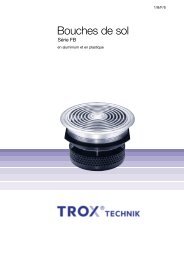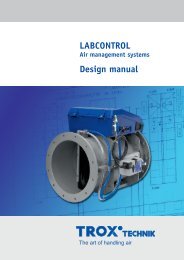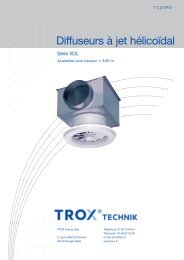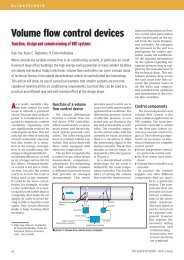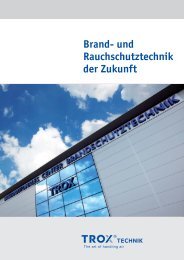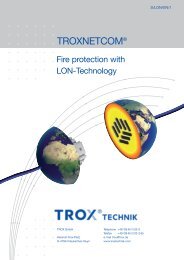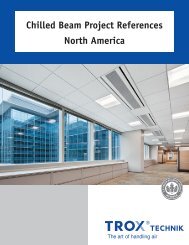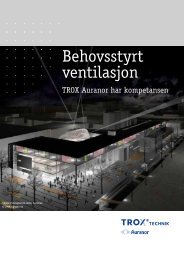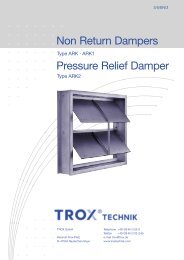Create successful ePaper yourself
Turn your PDF publications into a flip-book with our unique Google optimized e-Paper software.
Applications<br />
Comfort and IAQ benefits of chilled beam systems<br />
Properly designed chilled beam systems generally<br />
result in enhanced thermal comfort and indoor air<br />
quality compared to all-air systems.<br />
<br />
Active chilled beams generally deliver a<br />
constant air volume flow rate to the room. As<br />
such, variations in room air motion and cold air<br />
dumping that are inherent to variable volume<br />
all-air systems are minimized.<br />
• The constant air volume delivery of primary air<br />
to the active chilled beam helps assure that<br />
the design space ventilation rates and relative<br />
humidity levels are closely maintained.<br />
<strong>Chilled</strong> beam application criteria<br />
Although the advantages of using chilled beams are<br />
numerous, there are restrictions and qualifications that<br />
should be considered when determining their suitability<br />
to a specific application. <strong>Chilled</strong> beams are suitable for<br />
use where the following conditions exist:<br />
• Mounting less than 20 feet. Ceiling heights<br />
may be greater, but the beam should generally<br />
not be mounted more than 20 feet above the<br />
floor.<br />
• The tightness of the building envelope is<br />
adequate to prevent excessive moisture<br />
transfer. Space moisture gains due to<br />
occupancy and/or processes are moderate.<br />
• Space humidity levels can be consistently<br />
maintained such that the space dew point<br />
temperature remains below the temperature of<br />
the chilled water supply.<br />
• Passive beams should not be used in areas<br />
where considerable or widely variable air<br />
velocities are expected.<br />
• Passive beams should only be considered<br />
when an adequate entry and discharge area<br />
can be assured.<br />
• Passive <strong>Chilled</strong> beams can not be used to<br />
heat.<br />
Applications best served by chilled beams<br />
<strong>Chilled</strong> beams are ideal for applications with high space<br />
sensible cooling loads, relative to the space ventilation<br />
and latent cooling requirements. These applications<br />
include, but are not limited to:<br />
1) Brokerage trading areas<br />
Trading areas consists of desks where a<br />
single trader typically has access to multiple<br />
computer terminals and monitors. This high<br />
equipment density results in space sensible<br />
cooling requirements considerably higher than<br />
conventional interior spaces while the ventilation<br />
and latent cooling requirements are essentially<br />
the same. Active chilled beams remove<br />
60 to 70% of the sensible heat by<br />
means of their water circuit, reducing the<br />
ducted airflow requirement proportionally.<br />
2) Broadcast and recording studios<br />
Broadcast and recording studios typically<br />
have high sensible heat ratios due to their<br />
large electronic equipment and lighting loads.<br />
In addition, space acoustics and room air<br />
velocity control are critical in these spaces.<br />
Passive chilled beams are silent and capable<br />
of removing large amounts of sensible heat,<br />
enabling the use of a low velocity supply air<br />
discharge.<br />
3) Heat driven laboratory spaces<br />
<strong>Design</strong>ers often classify laboratories according<br />
to their required supply airflow rate. In<br />
laboratories that are densely populated by<br />
fume hoods, the make up air requirement is<br />
typically 12 air changes per hour or more.<br />
These laboratory spaces are classified as air<br />
driven. Laboratories whose make up air<br />
requirement is less than that are typically<br />
considered heat driven. This category includes<br />
most biological, pharmaceutical, electronic<br />
and forensic laboratories. The ventilation requirement<br />
in these laboratories is commonly 6<br />
to 8 air changes per hour, however, the processes<br />
and equipment in the laboratory can<br />
often result in sensible heat gains that require<br />
18 to 22 air changes with an all-air system. To<br />
make matters worse, recirculation of air<br />
exhausted from these laboratories is not<br />
allowed if their activities involve the use of<br />
gases or chemicals.<br />
Active chilled beams remove the majority (60<br />
to 70%) of the sensible heat by means of their<br />
chilled water coil, enabling ducted airflow rates<br />
to be reduced accordingly. Not only is the<br />
space more efficiently conditioned, but the<br />
ventilation (cooing and heating) load at the air<br />
handler is substantially reduced as far less<br />
outdoor air is required.<br />
9




